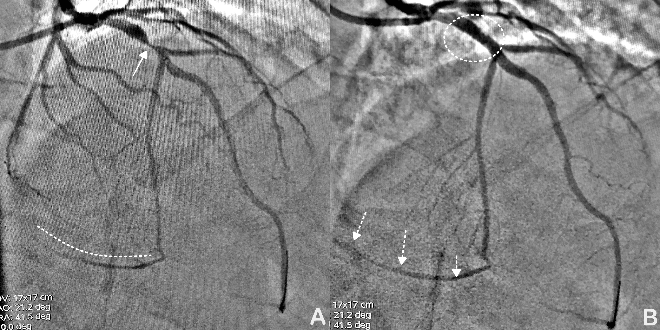Journals
The Origin of The Posterior Descending Artery from the 1st Septal Perforator: A Rare Anomaly
A B S T R A C T
The origin of the posterior descending artery [PDA] from the left anterior descending artery [LAD] or its branches is a rare coronary anomaly. The critical coronary lesions before the origin of the PDA in this circumstance can lead to large ischemia or infarction, which can be fatal. Coronary angiography is the investigation of choice. These patients should undergo early revasculazation.
Keywords
Congenital coronary anomalies, hyperdominant LAD, coronary angiography, percutaneous coronary intervention
Introduction
60years-old-male, hypertensive admitted with rest angina for 2 days with electrocardiography, echocardiography and elevated cardiac enzymes suggestive of anterior non-ST-elevation myocardial infarction with mild left ventricular dysfunction. Coronary angiography revealed discrete critical stenosis of the left anterior descending artery [LAD] with the origin of the posterior descending artery [PDA] from the 1st septal branch of the LAD. (Figure 1A) The circumflex gave origin to the postero-lateral branches and the right coronary artery was non-dominant. Percutaneous coronary intervention using a drug-eluting stent was done (Figure 1B) and the post-procedure patient was discharged the next day on dual antiplatelet agents, beta-blocker, and statins.
We have described hyper-dominant LAD where the LAD continued as PDA in the posterior interventricular groove also called as type IV LAD [1]. The septal origin of the PDA is very rare anomaly and should be considered under the category of hyper-dominant LAD. The entire RCA or PDA can originate from the 1st septal perforator [2]. The clinical significance of this variant is that it could be fatal if LAD occludes before the septal as it will involve a larger myocardium secondary to ischemia/infarction. Our patient had milder symptoms, as there was still a TIMI III flow despite the critical stenosis of the LAD.
Conflict of interest
There are no conflicts of interest related to any part of the article.
Abbreviations
PDA: posterior descending artery; LAD: left anterior descending; PCI: percutaneous coronary intervention; TIMI: thrombolysis in myocardial infarction.
Figure 1A, B: Coronary angiography showing the anomalous origin of the PDA [Curved dashed white line, Panel A] from the 1st septal perforator. The LAD had critical stenosis before the origin of the 1st septal perforator [Solid white arrow, Panel A]. The patient underwent PCI using drug-eluting stent [Dashed white circle], which improved flow [TIMI III] to the entire left coronary system including anomalous PDA [Dashed white arrows].
Article Info
Article Type
Images in InterventionPublication history
Received: Sun 16, Jun 2019Accepted: Tue 06, Aug 2019
Published: Mon 19, Aug 2019
Copyright
© 2023 Pankaj Jariwala. This is an open-access article distributed under the terms of the Creative Commons Attribution License, which permits unrestricted use, distribution, and reproduction in any medium, provided the original author and source are credited. Hosting by Science Repository.DOI: 10.31487/j.JICOA.2019.02.06
Author Info
Corresponding Author
Pankaj JariwalaDepartment of Cardiology, Yashoda Hospitals, Somajiguda, Raj Bhavan Road, Hyderabad, Telangana
Figures & Tables

References
- Jariwala P, Padma Kumar EA (2018) Hyper-dominant left anterior descending coronary artery with continuation as a posterior descending artery-An extended empire. J Saudi Hear Assoc 30: 284-289. [crossref]
- Gerardo M, Ferdinando I, Emiliano B, Clotilde T, Maurizio C (2016) Anomalous Origin of the Right Coronary Artery from the Left Anterior Descending Artery: A Rare Angiographic Finding. J Hear Circ 2: 122-129.
